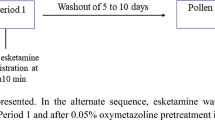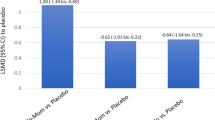Abstract
The aim of the studies described in the present report was to determine the systemic bioavailability of intranasal fluticasone propionate (FP) in healthy volunteers and in patients with atopic rhinitis. In addition, the effect that any FP that was absorbed may have on the hypothalamic pituitary (HPA) axis was also determined. In six separate studies, subjects were administered FP intranasally either once or twice daily for up to 7.5 days. In studies where FP was given once daily, doses ranged from 0.2 to 1mg. In studies where FP was given twice daily, dosages up to 2.0mg twice daily were given. At intervals following the last dose of FP, blood samples were taken for determination of plasma levels of FP and, in a number of studies, cortisol. In some studies, urine was collected for 24 hours following the last dose of FP for the determination of urinary cortisol excretion. Following repeated administration of FP (up to 1.0mg twice daily for 7.5 days), plasma levels of FP remained below the lower limit of detection (0.05 μg/L) for the 8-hour investigational period after the last dose of FP. When FP (0.2mg) was administered intranasally to patients with allergic rhinitis after challenge with allergen, plasma levels of FP remained below the lower limit of detection for 6 hours after administration with FP. Following administration of single and repeated doses of FP intranasally (up to 1.0mg twice daily for 7 days), no significant reduction in plasma cortisol concentrations could be measured. In the same subjects dexamethasone (2mg orally) reduced plasma cortisol concentrations from 143.0 ± 6.39 μg/L to < 10 μg/L. Neither single (up to l.Omg) nor repeated (up to 2.0mg twice daily for 7 days) administration of FP caused a significant reduction in urinary cortisol excretion. Even at doses 10 times higher than the dose used clinically, absorption of FP from the nasal mucosa was low (< 2%). It is concluded that any FP that is absorbed from the nasal mucosa is insufficient to exert any measurable effect on the HPA axis.
Similar content being viewed by others
References
Howarth PH. The immunopharmacology of rhinitis. In: Mackay IS, editor. Rhinitis, mechanisms and management. London, New York: Royal Society of Medicine Services Ltd, 1989: 33–51
Mackay IS. Topical medical management of allergic conditions of the nose. Pt 2: Intranasal steroids. In: Mackay IS, editor. Rhinitis, mechanisms and management. London, New York: Royal Society of Medicine Services Ltd, 1989; 183–98
Phillipps GH. Structure-activity relationships of topically active steroids: the selection of fluticasone propionate. Respir Med 1990; 84: 19–23
Meltzer ED, Orgel HA, Bronsky EA, et al. A dose-ranging study of fluticasone propionate aqueous nasal spray for seasonal allergic rhinitis assessed by symptoms, rhinomanometry and nasal cytology. J. Allergy Clin Immunol 1990; 86: 221–30
Nathan RA, Bronsky EA, Fireman P, et al. Once daily fluticasone propionate aqueous nasal spray is an effective treatment for seasonal allergic rhinitis. Ann Allergy 1991; 67: 332–8
Ventresca GP, Mackie AE, Moss JA, et al. Absorption of oral fluticasone propionate in healthy subjects. Am J Respir Crit Care Med 1994; 149: A214
Falcoz C, Mackie AE, McDowall J, et al. Oral bioavailability of fluticasone propionate in healthy subjects. Br J Clin Pharmacol 1996; 41: 459P–460P
McDowall JE, Mackie AE, Bye A, et al. Very low systemic exposure to intranasal fluticasone propionate. J Allergy Clin Immunol 1995; 51: A213
Bain BM, Harrison G, Jenkins KD, et al. A sensitive radioimmunoassay, incorporating solid-phase extraction, for fluticasone 17-propionate in plasma. J Pharm Biomed Anal 1993; 11: 557–61
Ayres JG, Bateman ED, Lundback B, et al. High dose fluticasone propionate, 1mg daily versus fluticasone propionate, 2mg daily, or budesonide 1.6mg daily, in patients with chronic severe asthma. Eur Respir J 1995; 8: 579–86
Fuller R, Johnson M, Bye A. Fluticasone propionate — an update on preclinical and clinical experience. Respir Med 1995; 89Suppl. A: 3–18
Masuyama K, Jacobson MR, Rak S, et al. Topical glucocorticoid (fluticasone propionate) inhibits cells expressing mRNA for interleukin-4 in the nasal mucosa in allergeninduced rhinitis. Immunology 1994; 82: 192–9
Mackie AE, Ventresca GP, Fuller RW, et al. Pharmacokinetics of intravenous fluticasone propionate in healthy subjects. Br J Clin Pharmacol 1996; 41: 539–42
Edsbacker S, Andersson K-E, Ryerfeldt A. Nasalbioavailability and systemic effects of the glucocorticoid budesonide in man. Eur J Clin Pharmacol 1985; 29: 477–81
Pakes GE, Brogden RN, Heel RC, et al. Flunisolide: a review of its pharmacological properties and therapeutic efficacy in rhinitis. Drugs 1980; 19: 397–411
Author information
Authors and Affiliations
Rights and permissions
About this article
Cite this article
McDowall, J.E., Mackie, A.E., Ventresca, G.P. et al. Pharmacokinetics and Bioavailability of Intranasal Fluticasone in Humans. Clin. Drug Investig. 14, 44–52 (1997). https://doi.org/10.2165/00044011-199714010-00006
Published:
Issue Date:
DOI: https://doi.org/10.2165/00044011-199714010-00006




